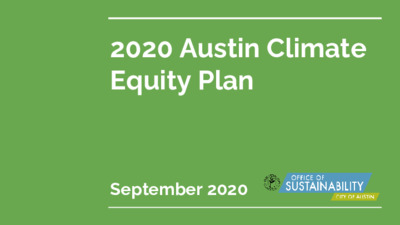Backup_ATCFPB_Climate Equity Plan_Presentation_20200914 — original pdf
Backup

2020 Austin Climate Equity Plan September 2020 Summary ● We’ve been updating the Community Climate Plan o Draft for public comment out until September 30 o Council likely November 12 ● What we’re looking for from you: ○ Comments ○ Areas of Interest ○ Pledge of Support How was this plan update created? • 24 City Staff • 120 Community Members (NGO, Govt., Business) • 12 Ambassadors • 4 Equity Trainings • 5 Community Workshops (over 250 attendees) • 14 Steering Committee Meetings • 60+ Advisory Group Meetings • 50+ Interviews by Ambassadors A History of Inequities that Remains Today • The Austin 1928 Master Plan divided the city along racial lines, forcibly displacing Black residents into specific, undesirable areas. • The Tank Farm fuel storage facility, Eastside Landfill, and the Holly Power Plant exposed people of color to toxic pollution in East Austin neighborhoods. • Gentrification is taking place in parts of the city where low-income people and people of color have been forced to live, the African-American share of the Austin population declined from 12% in 1990 to 7.7% in 2010. • As of 2015, 52% of white Austin residents were homeowners, only 27% of African-American and 32% of Hispanic/Latinx residents owned homes. • Cases of COVID-19, hospitalization and mortality rates are disproportionately affecting Latinx and Black communities We are Changing the Earth’s Climate Warming over 2℃could be catastrophic to life on earth Climate Projections for Austin • Low-income communities and communities of color are disproportionately affected by climate hazards • • Experience climate shocks on top of existing economic stressors • Have less resources to bounce back from event Suffer long-term impacts to mental and physical health Our Commitment to Climate Equity Climate Change Eliminate the use of fossil fuels for energy & transportation Health Affordability Accessibility Energy efficiency Renewable energy Less dependence on cars Electric vehicles • • • • • More trees & natural spaces Healthier consumer choices • Cultural Preservation Community Capacity Just Transition Accountability Racial Equity Eliminate disparities that can be predicted by race • • • • • • Safety for all at all times No disproportionate economic outcomes Fair access to services for all Inclusive participation in our city Positive health outcomes for all Embrace culture & difference If we’re not proactively addressing equity, we’re perpetuating injustice. Net-zero by 2050 → Net-zero by 2040 The updated Net-zero by 2040 target has a more aggressive emissions reduction target than the previous Net- zero by 2050 target A Plan Among Plans 5 Plan Sections: • Sustainable Buildings • Transportation Electrification • Transportation & Land Use • Natural Systems • Consumption Water Forward Plan Austin Energy Generation Plan CapMetro - Project Connect Our Parks, Our Future Long Range Plan Zero Waste Master Plan Austin Community Climate Plan Austin Strategic Mobility Plan & Smart Mobility Roadmap Equity Process for Advisory Groups What is the history, and where are the inequities? What does the data tell us? Does the goal include a climate and equity component? Develop strategies with equity and historical context in mind. Review and revise as needed 5b Does the strategy meet our shared values? How can we ensure accountability and communicate results? 1 2 3 4 5 6 Equity-focused Engagement Community Climate Ambassadors Draft Goals & Strategies Summary 18 Goals - What needs to be accomplished by 2030 to keep us on track 75 Strategies - What should be implemented in the next 5 years to make progress Centered on Equity Throughout ● Prioritize incentives and target communications towards low-income communities and communities of color ● Specific focus on anti-displacement ● Focus on a just transition (training and jobs) for new industries and technology ● Prioritize health and other benefits for the Eastern Crescent ● Center communities of color in ongoing learning and studies Food and Product Consumption AG participants Food and Product Consumption Goal 1: By 2030, ensure 100% of Austinites, with a focus on the food insecure, can access a pro-climate, pro-health food system that is community-driven, prioritizes regenerative agriculture, supports dietary and health agency, prefers plant-based over animal-based foods and minimizes food waste. Strategies: Equity Highlights: • • Support institutional food purchasing • Promote and fund community- driven food retail programs Incentivize pro-health, pro-climate food choices • Conduct a food waste root cause analysis • Focuses on food insecurity and promoting affordable, culturally- relevant food • Supports local businesses • Provides employment opportunities for low-income communities and communities of color Natural Systems AG participants Natural Systems Regenerative Agriculture Natural Systems Goal 2: By 2030, protect 500,000 acres of farmland in the 5-county region through legal protections and/or regenerative agriculture programs. Strategies: Equity Highlights: • Protect working lands • Improves health outcomes and • Reform agricultural tax appraisals benefits low-income communities in and • Support farmers through financial around agricultural lands by assistance removing pollutants through use of • Provide farmers with resources regenerative practices • Expand composting • Supports social and economic community • Offer workforce development for farmers resilience through local food production Natural Systems Goal 4: By 2030, include all City-owned lands under a management plan that results in neutral or negative carbon emissions and maximizes community co-benefits. Strategies: Equity Highlights: • Prioritize carbon neutrality for • Provides health and cultural benefits through public lands access to green space • Reclaim public space • Increases cultural relevancy of green spaces • Promote community • Offers programs that allow community stewardship members to benefit from stewardship of public • Promote carbon farming lands and centers community values Thank you! More information: ● austintexas.gov/climateplan ● SpeakUp Austin!